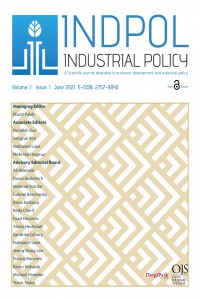Abstract
This paper examines the process of structural change and export
diversification that took place in five selected Southern African economies
since the early 1970s. Making use of several complementary data sources, the
paper highlights the important differences that characterized the experiences
of different countries and discusses the main challenges and opportunities that
these countries, and the region as a whole, will face in the years to come.
Keywords
Structural transformation productivity growth Southern Africa Product Space and Regional Integration Product Space and Regional Integration
References
- Abdon A and Felipe J (2011). The Product Space: What Does It Say About the Opportunities for Growth and Structural Transformation of Sub-Saharan Africa? Levy Economics Institute.
- Balassa B (1965). Trade liberalisation and “revealed” comparative advantage. The Manchester School of Economic and Social Studies. 33(2):99–123.
- Balassa B (1977). “Revealed” comparative advantage revisited: An analysis of relative export shares of the industrial countries, 1953–1971. The Manchester School of Economic and Social Studies. 45(4):327–344.
- Grossman G and Helpman E (1991). Trade, knowledge spillovers, and growth. European Economic Review. 35(2-3):517-526. Hausmann R and Klinger B (2007). The structure of the product space and the evolution of comparative advantage. CID Working Paper No. 146.
- Hausmann R, Hidalgo CA, Bustos S, Coscia M, Simoes A and Yildirim MA (2011). The Atlas of Economic Complexity. The MIT Press. Cambridge and London.
- Hausmann R, Hwang J and Rodrik D (2007). What you export matters. Journal of Economic Growth. 12(1):1–25.
- Herrendorf B, Herrington C and Valentinyi A (2015). Sectoral technology and structural transformation. American Economic Journal: Macroeconomics. 7(4):104–133.
- Herrendorf B, Rogerson R and Valentinyi A (2013). Growth and structural transformation. No. w18996. National Bureau of Economic Research.
- Hidalgo C (2011). Discovering East Africa’s industrial opportunities. The German Marshall Fund of the United States Economic Policy Paper Series 2011. Washington, D.C.
- Hidalgo C, Klinger B, Barabási AL and Hausmann R (2007). The product space conditions the development of nations. Science. 317(5837):482–487.
- Kuznets S (1973). Modern Economic Growth: Findings and Reflections. American Economic Review. 63(3):247–258. Lewis A (1954). Economic Development with Unlimited Supplies of Labour. The Manchester School of Economic and Social Studies. 22(2):139–191.
- McMillan M and Rodrik D (2011). Globalization, Structural Change and Productivity Growth. In: Bacchetta M and Jansen M, eds. Making Globalization Socially Sustainable. International Labour Organization. Geneva.
- Ranis G and Fei CH (1961). A Theory of Economic Development. American Economic Review. 51(4):533-565.
- Solow, Robert M (1956). A contribution to the theory of economic growth. The Quarterly Journal of Economics. 70(1):65–94.
- UNCTAD (2016a). Trade and Development Report 2016: Structural transformation for inclusive and sustained growth. United Nations publication. Sales No: E.16.II.D.5. New York and Geneva.
- UNCTAD (2016b). Virtual Institute Teaching Material on Structural Transformation and Industrial Policy. United Nations. New York and Geneva.
- United Nations Economic and Social Council (2017). Progress Towards the Sustainable Development Goals: Report of the Secretary-General. E/2017/66. 11 May.
Details
| Primary Language | English |
|---|---|
| Subjects | Economics |
| Journal Section | Research Articles |
| Authors | |
| Publication Date | June 1, 2021 |
| Published in Issue | Year 2021 Volume: 1 Issue: 1 |


